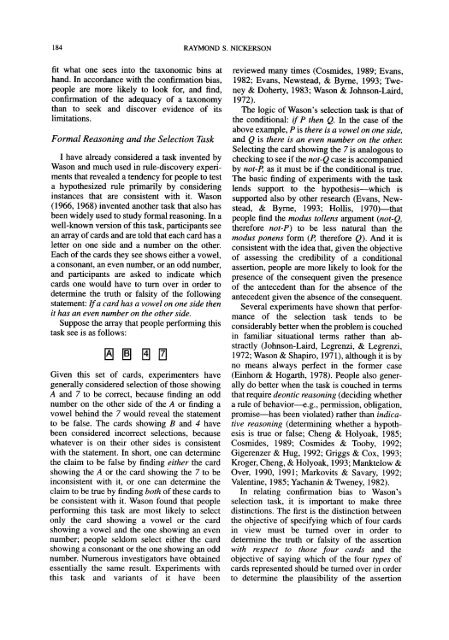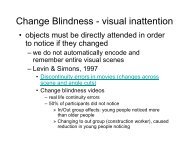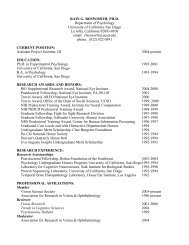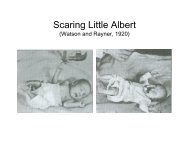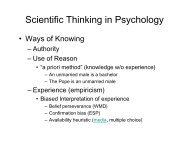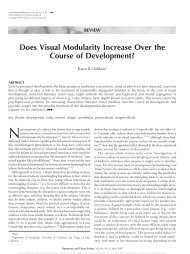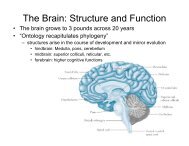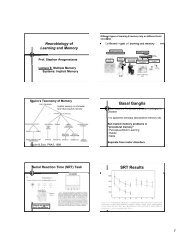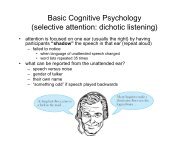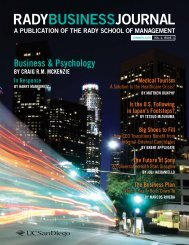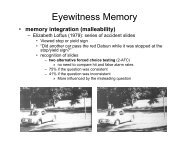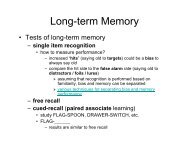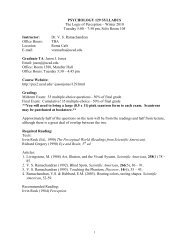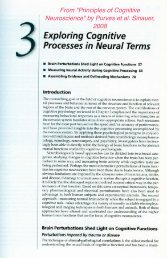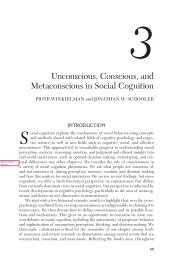Confirmation Bias: A Ubiquitous Phenomenon in Many Guises
Confirmation Bias: A Ubiquitous Phenomenon in Many Guises
Confirmation Bias: A Ubiquitous Phenomenon in Many Guises
Create successful ePaper yourself
Turn your PDF publications into a flip-book with our unique Google optimized e-Paper software.
184 RAYMOND S. NICKERSON<br />
fit what one sees <strong>in</strong>to the taxonomic b<strong>in</strong>s at<br />
hand. In accordance with the confirmation bias,<br />
people are more likely to look for, and f<strong>in</strong>d,<br />
confirmation of the adequacy of a taxonomy<br />
than to seek and discover evidence of its<br />
limitations.<br />
Formal Reason<strong>in</strong>g and the Selection Task<br />
I have already considered a task <strong>in</strong>vented by<br />
Wason and much used <strong>in</strong> rule-discovery experiments<br />
that revealed a tendency for people to test<br />
a hypothesized rule primarily by consider<strong>in</strong>g<br />
<strong>in</strong>stances that are consistent with it. Wason<br />
(1966, 1968) <strong>in</strong>vented another task that also has<br />
been widely used to study formal reason<strong>in</strong>g. In a<br />
well-known version of this task, participants see<br />
an array of cards and are told that each card has a<br />
letter on one side and a number on the other.<br />
Each of the cards they see shows either a vowel,<br />
a consonant, an even number, or an odd number,<br />
and participants are asked to <strong>in</strong>dicate which<br />
cards one would have to turn over <strong>in</strong> order to<br />
determ<strong>in</strong>e the truth or falsity of the follow<strong>in</strong>g<br />
statement: If a card has a vowel on one side then<br />
it has an even number on the other side.<br />
Suppose the array that people perform<strong>in</strong>g this<br />
task see is as follows:<br />
Given this set of cards, experimenters have<br />
generally considered selection of those show<strong>in</strong>g<br />
A and 7 to be correct, because f<strong>in</strong>d<strong>in</strong>g an odd<br />
number on the other side of the A or f<strong>in</strong>d<strong>in</strong>g a<br />
vowel beh<strong>in</strong>d the 7 would reveal the statement<br />
to be false. The cards show<strong>in</strong>g B and 4 have<br />
been considered <strong>in</strong>correct selections, because<br />
whatever is on their other sides is consistent<br />
with the statement. In short, one can determ<strong>in</strong>e<br />
the claim to be false by f<strong>in</strong>d<strong>in</strong>g either the card<br />
show<strong>in</strong>g the A or the card show<strong>in</strong>g the 7 to be<br />
<strong>in</strong>consistent with it, or one can determ<strong>in</strong>e the<br />
claim to be true by f<strong>in</strong>d<strong>in</strong>g both of these cards to<br />
be consistent with it. Wason found that people<br />
perform<strong>in</strong>g this task are most likely to select<br />
only the card show<strong>in</strong>g a vowel or the card<br />
show<strong>in</strong>g a vowel and the one show<strong>in</strong>g an even<br />
number; people seldom select either the card<br />
show<strong>in</strong>g a consonant or the one show<strong>in</strong>g an odd<br />
number. Numerous <strong>in</strong>vestigators have obta<strong>in</strong>ed<br />
essentially the same result. Experiments with<br />
this task and variants of it have been<br />
reviewed many times (Cosmides, 1989; Evans,<br />
1982; Evans, Newstead, & Byrne, 1993; Tweney<br />
& Doherty, 1983; Wason & Johnson-Laird,<br />
1972).<br />
The logic of Wason's selection task is that of<br />
the conditional: if P then Q. In the case of the<br />
above example, P is there is a vowel on one side,<br />
and Q is there is an even number on the other.<br />
Select<strong>in</strong>g the card show<strong>in</strong>g the 7 is analogous to<br />
check<strong>in</strong>g to see if the not-Q case is accompanied<br />
by not-P, as it must be if the conditional is true.<br />
The basic f<strong>in</strong>d<strong>in</strong>g of experiments with the task<br />
lends support to the hypothesis—which is<br />
supported also by other research (Evans, Newstead,<br />
& Byrne, 1993; Hollis, 1970)—that<br />
people f<strong>in</strong>d the modus tollens argument (not-Q,<br />
therefore not-P) to be less natural than the<br />
modus ponens form (P, therefore Q). And it is<br />
consistent with the idea that, given the objective<br />
of assess<strong>in</strong>g the credibility of a conditional<br />
assertion, people are more likely to look for the<br />
presence of the consequent given the presence<br />
of the antecedent than for the absence of the<br />
antecedent given the absence of the consequent.<br />
Several experiments have shown that performance<br />
of the selection task tends to be<br />
considerably better when the problem is couched<br />
<strong>in</strong> familiar situational terms rather than abstractly<br />
(Johnson-Laird, Legrenzi, & Legrenzi,<br />
1972; Wason & Shapiro, 1971), although it is by<br />
no means always perfect <strong>in</strong> the former case<br />
(E<strong>in</strong>horn & Hogarth, 1978). People also generally<br />
do better when the task is couched <strong>in</strong> terms<br />
that require deontic reason<strong>in</strong>g (decid<strong>in</strong>g whether<br />
a rule of behavior—e.g., permission, obligation,<br />
promise—has been violated) rather than <strong>in</strong>dicative<br />
reason<strong>in</strong>g (determ<strong>in</strong><strong>in</strong>g whether a hypothesis<br />
is true or false; Cheng & Holyoak, 1985;<br />
Cosmides, 1989; Cosmides & Tooby, 1992;<br />
Gigerenzer & Hug, 1992; Griggs & Cox, 1993;<br />
Kroger, Cheng, & Holyoak, 1993; Manktelow &<br />
Over, 1990, 1991; Markovits & Savary, 1992;<br />
Valent<strong>in</strong>e, 1985; Yachan<strong>in</strong> & Tweney, 1982).<br />
In relat<strong>in</strong>g confirmation bias to Wason's<br />
selection task, it is important to make three<br />
dist<strong>in</strong>ctions. The first is the dist<strong>in</strong>ction between<br />
the objective of specify<strong>in</strong>g which of four cards<br />
<strong>in</strong> view must be turned over <strong>in</strong> order to<br />
determ<strong>in</strong>e the truth or falsity of the assertion<br />
with respect to those four cards and the<br />
objective of say<strong>in</strong>g which of the four types of<br />
cards represented should be turned over <strong>in</strong> order<br />
to determ<strong>in</strong>e the plausibility of the assertion


